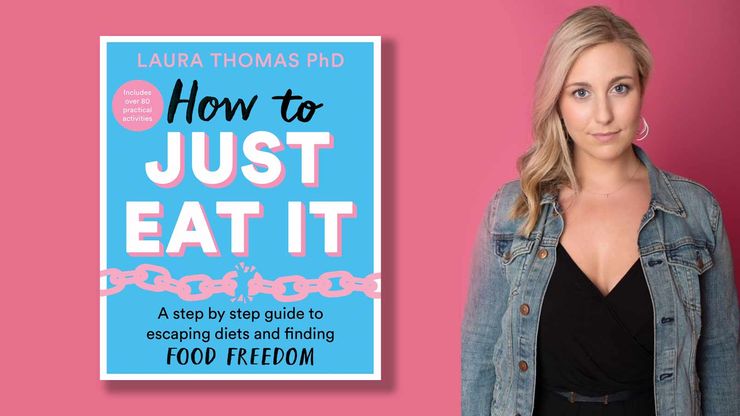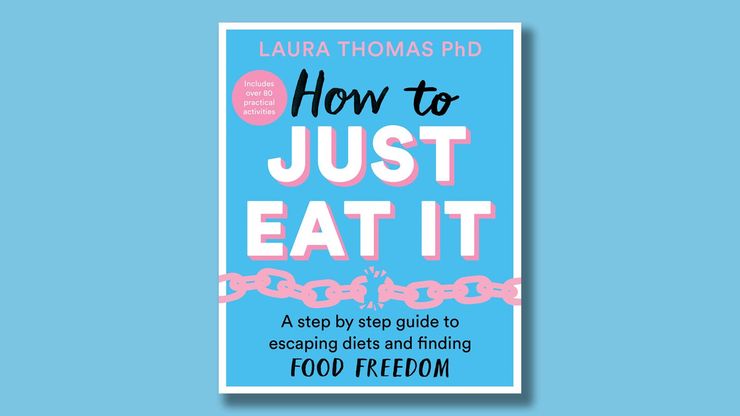Try this one simple thing to understand your hunger cues
With so many conflicting messages around food, it’s no surprise that as we get older we sometimes struggle to understand our body’s hunger cues. Here, intuitive eating expert Laura Thomas guides us through an exercise to help us reconnect to our hunger and recognise our body’s signals.

Do you ever find yourself asking ‘am I hungry, or am I stressed/tired/bored?’ It’s unsurprising we often second guess ourselves, with constant mixed messages about food and diets from the media, friends and family. Laura Thomas, a registered nutritionist and the author of How to Just Eat It, is here to explain how intuitive eating can help you develop a better relationship with food and your body. In How to Just Eat It Laura uses practical advice and simple activities based on intuitive eating to help free you from restrictive dieting and punishing exercise.
Intuitive eating is a framework which teaches skills and tools to help you listen to your body’s physiological cues, and learn to eat according to your body’s natural appetite. Here, Laura guides us through an exercise designed to help you recognize your body’s hunger signals.
Helping clients learn to tune into their body’s signals for hunger is my favourite part of supporting someone through the Intuitive Eating framework. ‘Eat when you’re hungry’ is not the most radical or provocative concept in intuitive eating by a long shot, but it is one of the trickiest to master and has the most profound impact on their relationship with food.
When we are born, our instincts around food are strong and the signals for it loud and clear. My six month old literally screams the house down if I miss his early hunger cues! But over time, we lose connection to those innate feelings. It begins early on in childhood when our intuition begins to be undermined by well-meaning adults. We are encouraged to take another bite when we might be full or not like the food, or told we can’t possibly be hungry again. We receive messages about ‘good’ and ‘bad’ foods and ‘naughties’ and ‘treats’ which puts food up onto a pedestal creating a forbidden fruit effect. This can cause us to completely ignore our body’s cues because we have learned that some food is only allowed on ‘special occasions’, so we have to eat it ALL. RIGHT. NOW. in case we’re not allowed it any more.
As kids grow up and become teens and eventually adults, they start to internalise messages equating body size to health and beauty. They learn that to be accepted and successful, they must obey the rules of diet culture: don’t eat after X time at night, only eat X calories a day, a portion = X crisps/nuts/grapes. These external rules replace the connection we have to internal cues.
As adults we believe that hunger is a problem or a nuisance and we need to deploy strategies to ‘overcome it’, none of which involve actually eating a meal or snack! Some of the things my clients tell me they have done to avoid feeling hungry include: drinking copious amounts of herbal teas, black coffee or diet sodas, having a cigarette, taking appetite suppressant lollipops or pills and drinking ‘skinny teas’ – some even go to bed early to try and control their appetite.
Given how complicated our relationship with hunger has become, it’s easy to see why we are completely disconnected and distrustful of our body’s signals. To help us reconnect, an activity I really enjoy doing with clients involves this hunger body scan. In a session I’ll guide them through the body scan, checking in with the various areas where hunger can show up in the body and inevitably afterwards the client will (to their surprise) realise that they are actually starting to get a little hungry. I’ll offer them a snack and we’ll redo the activity at the end of the session so they can notice the difference in the body after having something to eat.
You can practice this yourself using the recording below. Try doing it a little while after having a meal or snack so you know you will have a degree of hunger. Note on the table below which sensations you notice – there are no right or wrong answers here, you’re just gathering information. Then have something to eat and wait ten or so minutes before redoing it. Using the table below, notice the areas where you felt a difference: your mood, your energy, your head, your stomach or your overall body! This will help you differentiate your hunger signals from other sensations (like tiredness for instance).
Hunger scan script
Hunger scan table

Remember too that intuitive eating is not about *only* eating when you’re hungry. Sometimes we eat just because something tastes really good and without it you’d feel restricted and deprived. Other times we eat when we’re not that hungry because we have to jump into a three-hour meeting and know that if we didn’t have a snack now we’d be crashing hard halfway through the meeting.
Eating when hungry isn’t a rule, it’s an invitation to explore how food tastes and how you feel when you’re gently hungry, but not ravenous. For most of us, this will be the sweet spot where food is satisfying and delicious, but you’re not so hungry that you’re about to gnaw your own arm off!
How to Just Eat It
by Laura Thomas
Nutritionist and bestselling author of Just Eat It Laura Thomas PhD is back with this practical self-help book to help you reframe your approach to food. She uses the principles of intuitive eating in order to develop a judgement-free attitude to food. Laura also helps us to understand and spot diet culture in the media and society. Her wonderful practice called ‘Diet Culture Bullsh*t Bingo’ involves spotting phrases such as ‘burning off food,’ ‘cleanse’ and ‘80/20 rule’ to help understand and learn to identify diet culture (and how it affects us) in everyday life, social media, TV and even our own language.
Photo credit: ©Liz Riley Photography



